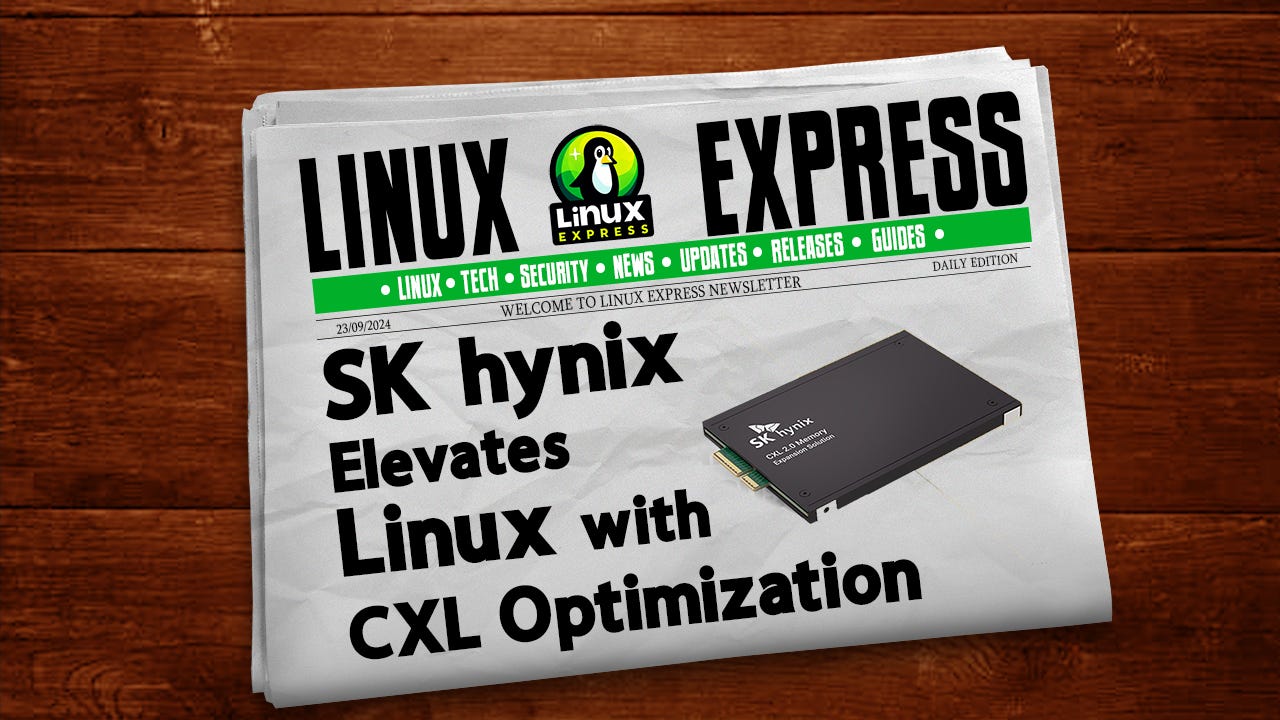SK hynix Elevates Linux with CXL Optimization: Transforming AI and Data Centers
SK hynix’s CXL optimization solution is now available on Linux, offering a powerful, scalable memory solution that’s ideal for AI and data-heavy applications.
On September 23, 2024, SK hynix announced a significant leap in memory technology by integrating its Compute Express Link (CXL) optimization solution into Linux, the world's largest open-source operating system. This move is a game-changer for developers and enterprises using high-performance computing systems for AI and data-heavy tasks.
By integrating its Heterogeneous Memory Software Development Kit (HMSDK) into Linux, SK hynix enables broader access to enhanced memory performance, marking a crucial step in commercializing CXL memory.
What is CXL, and Why is It Important?
Compute Express Link (CXL) is a next-generation interface designed to address a common computing system bottleneck: the CPU, GPU, and memory communication. Traditional memory architectures struggle with the bandwidth required for large-scale computations, especially in AI and machine learning. CXL optimizes this communication by providing an ultra-fast, scalable solution that can expand memory capacity by over 10 times compared to traditional methods.
CXL creates a high-speed connection between processors and memory, ensuring that large datasets can be processed more efficiently. This is particularly important for AI-driven systems, where models need vast data to operate in real-time. CXL significantly enhances performance by reducing latency and improving bandwidth, making it indispensable in data centers, cloud computing, and AI training.
How SK hynix's HMSDK Optimizes CXL Memory
SK hynix's Heterogeneous Memory Software Development Kit (HMSDK) is a proprietary tool designed to maximize the benefits of CXL memory by intelligently managing memory allocation. HMSDK works by differentially allocating memory based on bandwidth. It ensures that high-bandwidth tasks are handled more efficiently, expanding the memory bandwidth by over 30% without changing existing applications.
One of the most significant advantages of HMSDK is its access-frequency-based optimization. This feature tracks how frequently data is accessed and moves high-priority data to faster memory. The result? A performance boost of over 12%, especially for memory-intensive applications like AI and large-scale simulations.
This integration into Linux means developers worldwide can leverage these capabilities without needing specialized hardware changes. SK hynix's solution is set to become the standard for next-generation memory systems, particularly as the demand for high-performance AI solutions rises.
Why Linux?
Linux is the backbone of many critical computing systems, from supercomputers to cloud infrastructure. Its open-source nature makes it ideal for broad adoption and global collaboration. By integrating HMSDK into Linux, SK hynix ensures that CXL technology is accessible to many developers and enterprises.
Linux powers most AI research platforms and is widely used in data centers, making it the perfect environment for deploying CXL-optimized memory solutions. By embedding HMSDK into Linux, SK hynix positions itself at the forefront of innovation, enabling faster development of AI and data-intensive applications without requiring extensive system overhauls.
How Will This Impact AI and Data-Intensive Applications?
AI applications, especially large language models (LLMs) and machine learning frameworks depend heavily on memory. Traditional memory systems often become bottlenecks when handling large datasets or training massive models. With its ability to expand memory capacity by more than 10 times, CXL provides the scalability needed for these applications to run smoothly.
For example, AI models that rely on large datasets can load more data into memory simultaneously, reducing the need for constant data swapping between storage and memory. It speeds up computations and improves the real-time performance of AI models, making them more efficient and cost-effective.
HMSDK's access-frequency-based optimization also ensures that frequently accessed data is always available in the fastest memory. This feature is particularly useful for real-time decision-making applications like autonomous vehicles or advanced robotics.
The Benefits of SK hynix's CXL 2.0 Memory for Data Centers
The benefits of SK hynix's CXL 2.0 memory extend beyond AI applications to the broader landscape of data centers and high-performance computing. With the imminent commercialization of CXL 2.0 memory—available in capacities of 96GB and 128GB—data centers can scale memory resources more efficiently. This scalability allows data centers to support more users and process more data without investing heavily in new hardware.
Moreover, increasing memory bandwidth by 30% without modifying applications means that data centers can achieve these performance gains with minimal disruption. It is crucial as enterprises face growing data demands but limited budgets for infrastructure upgrades.
How Does SK hynix's Solution Compare to Other Memory Technologies?
While other memory solutions, such as DDR and HBM (High Bandwidth Memory), offer high performance, they often require specialized hardware or costly system overhauls. On the other hand, SK hynix's CXL solution provides a more flexible and scalable option by leveraging existing memory systems and optimizing them with HMSDK.
Compared to traditional memory expansion techniques, which often involve adding more physical memory, CXL expands memory using existing resources more efficiently. This cost-effective approach ensures that performance scales with demand, making it a superior choice for enterprises looking to maximize their memory investments.
Conclusion
Integrating SK hynix's CXL optimization solution into Linux marks a new era of in-memory technology. By offering unprecedented memory expansion and optimization, SK hynix is setting the stage for future advancements in AI, data centers, and high-performance computing. As the semiconductor industry anticipates full-scale commercialization of CXL in 2024, developers and enterprises alike can look forward to faster, more efficient, and scalable memory solutions. SK hynix is not just keeping pace with the future of computing—it's defining it.
Takeaway
With CXL-optimized memory now available in Linux, the future of AI and data-intensive computing looks brighter. SK hynix is leading the charge, offering solutions that improve memory performance and make advanced AI applications more accessible than ever.



